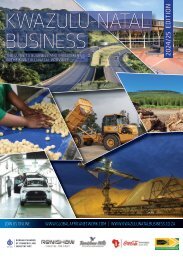Eastern Cape Business 2017 edition
The 2017 edition of Eastern Cape Business is the 10th issue of this highly successful publication that, since its launch in 2006, has established itself as the premier business and investment guide to the Eastern Cape Province. The Eastern Cape enjoys an abundance of natural and human resources, as well as established industrial infrastructure that drives the economy of the province. This includes three ports and two industrial development zones which are home to a wide range of manufacturers and exporters. The 2017 edition includes an in-depth look at the province’s two Industrial Development Zones, a focus on skills development and investment climate information from the Nelson Mandela Business Chamber and the Border-Kei Chamber of Business.
The 2017 edition of Eastern Cape Business is the 10th issue of this highly successful publication that, since its launch in 2006, has established itself as the premier business and investment guide to the Eastern Cape Province. The Eastern Cape enjoys an abundance of natural and human resources, as well as established industrial infrastructure that drives the economy of the province. This includes three ports and two industrial development zones which are home to a wide range of manufacturers and exporters.
The 2017 edition includes an in-depth look at the province’s two Industrial Development Zones, a focus on skills development and investment climate information from the Nelson Mandela Business Chamber and the Border-Kei Chamber of Business.
You also want an ePaper? Increase the reach of your titles
YUMPU automatically turns print PDFs into web optimized ePapers that Google loves.
OVERVIEW<br />
the east. Improving the agricultural<br />
yield of the eastern part of<br />
the province is vital for improving<br />
food security and lifting many<br />
thousands of people out of poverty.<br />
The recent national drought<br />
has put extra pressure on rural<br />
communities.<br />
Infrastructure plays an important<br />
role in the agricultural sector,<br />
and the repair of the road between<br />
Port Elizabeth and Addo has been<br />
welcomed by all the citrus farmers<br />
in the Addo/Kirkwood district. Big<br />
infrastructure projects have been<br />
undertaken in the eastern parts of<br />
the province by the <strong>Eastern</strong> <strong>Cape</strong><br />
Rural Development Agency.<br />
Three training centres focus<br />
on agriculture in the province:<br />
Fort Cox College of Agriculture<br />
and Forestry, Mpofu Training<br />
Centre (teaching mostly smallstock<br />
management) and the<br />
Tsolo Agricultural and Rural<br />
Development Institute, which<br />
is developing ties with Walter<br />
Sisulu University. The Dohne<br />
Agricultural Research Institute,<br />
near Stutterheim, developed a<br />
new breed of sheep, the Dohne<br />
merino.<br />
The large Magwa Tea Estate<br />
went into business rescue in<br />
2016. At its peak, Magwa produced<br />
about 2 700 tons of tea<br />
but more investment is now<br />
needed to make it (and its<br />
neighbouring estate Majola) a<br />
profitable business.<br />
Crops<br />
The <strong>Eastern</strong> <strong>Cape</strong> is South Africa’s<br />
second-largest producer of citrus<br />
fruit. Oranges make up the vast<br />
majority of citrus products (80%), but the province is also well-known<br />
for its clementine and satsuma tangerines, as well as navel oranges.<br />
Deciduous fruits such as apples, pears and apricots are grown primarily<br />
in the Langkloof Valley.<br />
Another crop in which the <strong>Eastern</strong> <strong>Cape</strong> leads national production<br />
is chicory. The roots are used for beverages such as instant coffee, the<br />
leaves go into pet food and stock feed and unopened leaf pods become<br />
chicory endives, a sought-after salad ingredient. The province produces<br />
between 18 000 and 20 000 tons of wet root every year, mostly near<br />
the coast at Alexandria and inland from Port Alfred. The entire crop is<br />
consumed in South Africa.<br />
The province’s pineapple crop, grown in the same part of the<br />
Sunshine Coast that produces chicory, is similarly largely for domestic<br />
consumption. Approximately 80 000 tons are produced every year<br />
and processed in East London.<br />
One of the fastest-growing sectors in agriculture is macadamia<br />
nuts. The ECRDA has partnered with a community to plant<br />
the popular nut at Ncera in the Tyume Valley north of Alice. The<br />
original planting of 150ha is being expanded by a further 30ha.<br />
The harvest of 49 tons in 2015 is expected to grow to 80 tons as<br />
the trees mature.<br />
Sheep and goats<br />
The long-term drought which has afflicted all regions in South Africa<br />
is having an effect on all sectors, but wool-producing sheep farmers<br />
and mohair-producing Angora goat producers perhaps less so,<br />
partly because they are so well adapted to dry conditions but also<br />
because farmers can reduce their flocks.<br />
33 EASTERN CAPE BUSINESS <strong>2017</strong>


















